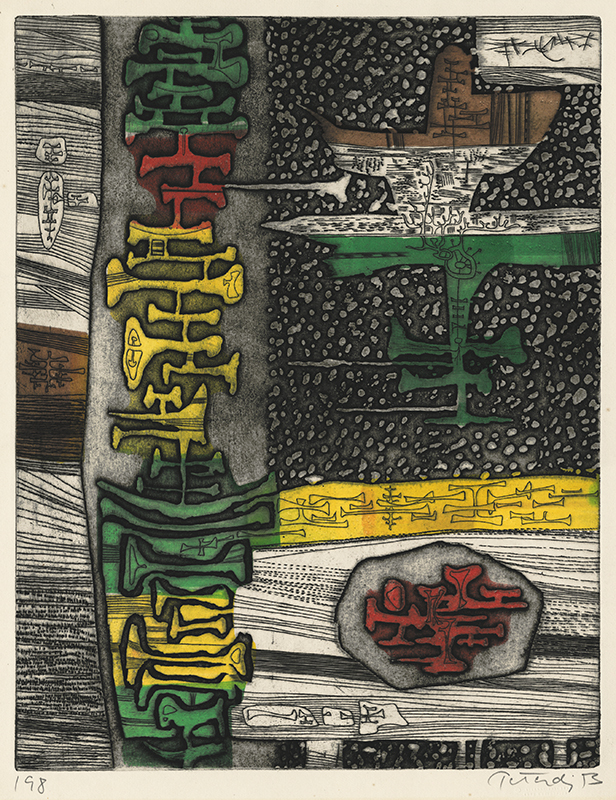
19th, 20th & 21st Century Fine Prints
707-546-7352 · fax 707-546-7924 · web: www.annexgalleries.com · email: artannex@aol.com
Seed and the Rock by Gabor Peterdi

Seed and the Rock
Gabor Peterdi
Seed and the Rock
Gabor Peterdi
1915 - 2001 (biography)This color intaglio utilizes many of the techniques that were being developed at Atelier 17, where Peterdi studied in Paris the 1930s and again in New York in the 40s. "Seed and the Rock” was created using relief etching for the background, engraving for the linear and negative elements, and four stenciled colors, printed offset.
"Seed and the Rock" was published by the International Graphic Arts Society (IGAS) in Series No 6, September, 1963. IGAS published a number of prints every year in editions of 210. 100 of these were sold in Europe and 100 in the US, there were 10 proofs for the artist. With this business model an artist's work could develop an international following, and many museums subscribed to their publications.
Peterdi commented: "My experience with the graphic arts started with engraving. I fell in love with it and I engraved for several years before I made my first etching. This self-imposed limitation had no other reason than the fascination to explore thoroughly this pure and powerful technique. When I started to work with the various methods of etching, I became aware of the immense range of this medium and plunged into a period of feverish experimentation." (Gabor Peterdi, "Printmaking." Macmillan Company, NY, 1959).
Gabor Peterdi was born on 17 September 1915 in Pestújhely, Hungary. He began his art studies at the Hungarian Academy in 1929 at the age of fourteen. His first solo exhibition was mounted at the Ernst Museum in 1930 and that same year Peterdi won a Prix de Rome scholarship for painting which allowed him to continue his studies at the Accademia di Belle Arti. The following year he went to Paris where he attended the Académie Julian and the Académie Scandinave. He joined Hayter’s Atelier 17 in Paris in 1933 where he explored the techniques of engraving.
Peterdi immigrated to the United States in 1939 and, later that year, his first American solo exhibition of paintings opened at the Julien Levy Gallery in New York. He soon became a US citizen and joined the military serving in Germany. After his military service, Peterdi resumed his printmaking career at Atelier 17 in New York. He found working with the copperplate cathartic after his military experiences. His first prints reflected the horrors and destruction of war, but he soon began representing natural awakenings and biblical beginnings in such works as Adam and Eve.
He began teaching at the School of the Brooklyn Museum in 1948, organizing the graphic arts workshop there. Peterdi’s creative approach to intaglio continued to expand as he invented new techniques and printed from larger plates. In 1952, he became Associate Professor of Art at Hunter College in New York, where he taught until 1959. In 1953, he began teaching at the Yale-Norfolk summer school, and he joined the art faculty of Yale University as a visiting professor, gaining a full-time appointment in 1960.


